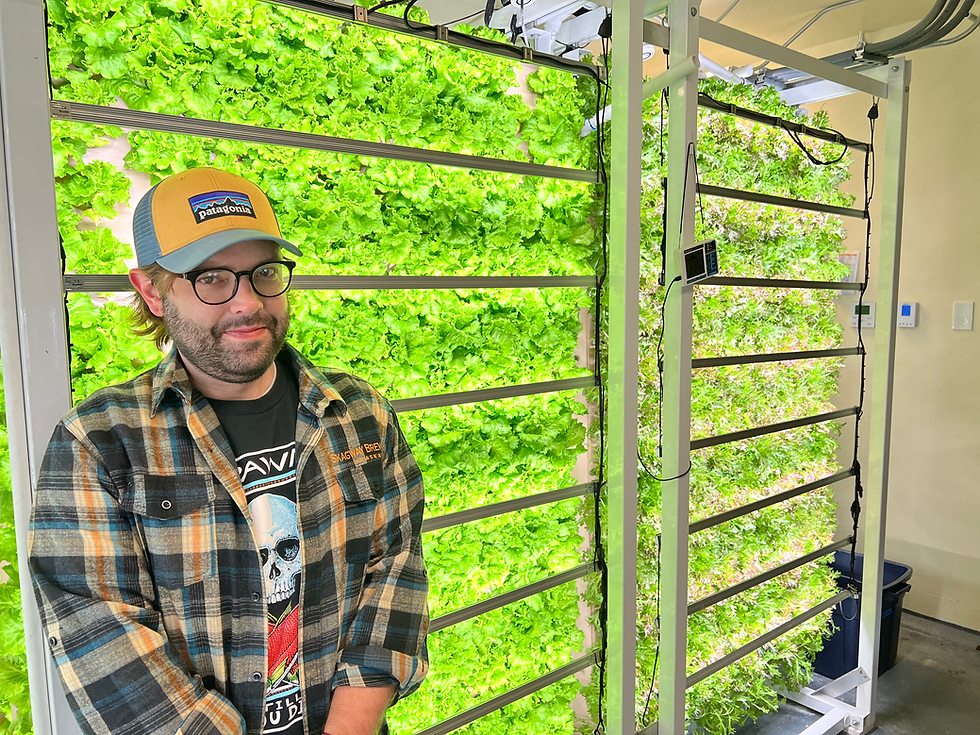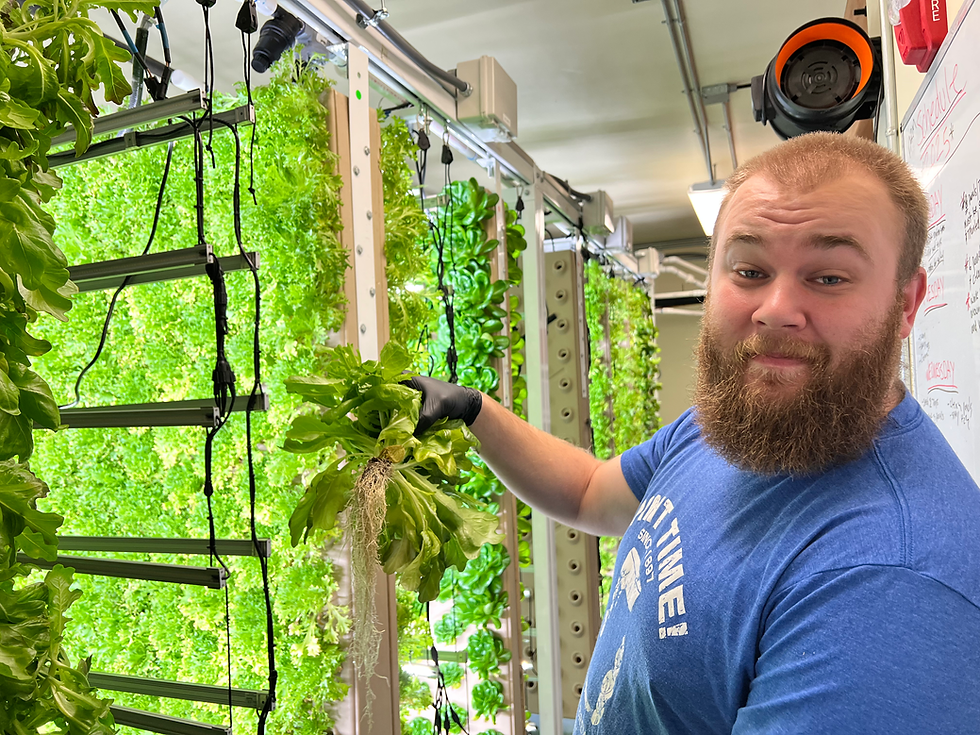
Indoor Farm
Indoor Farm
Aeroponics is a highly efficient closed-loop grow system that uses less water compared to other methods of food production.
No harmful pesticides, herbicides, or fungicides are used.
Plants are suspended with their canopy in the light and their roots are in the dark in an enclosed chamber.
A fine mist of nutrient-rich water is sprayed at regular intervals in the root chamber, which is absorbed by fine root hairs.
The root hairs increase the surface area of the roots which increases the nutrient-uptake capabilities.
Any nutrients not absorbed are recirculated back into the system, recycling H20 and nutrients.
The surplus of oxygen surrounding the roots accelerates the nutrient absorption by the root hairs which leads to a faster rate of growth.
The root chamber is an oxygen-rich environment where the roots can grow unencumbered. CO2 waste from the brewing process will be captured then diverted and used to increase production rate 25%.

Aeroponics is a method of growing plants without soil by suspending them in air and misting the roots with nutrient-rich water - we are growing living organisms that have all their “guts” exposed! - typically enclosed in a chamber that is dark and humid, to create a favorable environment for plant growth.
1. Definition:
The term "aeroponics" was first introduced by Richard J. Stoner II in 1983. He also invented the first commercial aeroponic system.
2. Discovery:
Aeroponic systems use up to 98% less water than traditional farming and about 60% less than other hydroponic applications, making it an extremely efficient way of farming in terms of water use. Additionally, they allow for faster growth of plants as the roots are directly exposed to oxygen.
3. Efficiency:
To give an idea of how large an area a 70-panel aeroponic system covers, consider this: Each panel is 6.5 feet by 5 feet, equating to 32.5 square feet. Therefore, 70 panels would cover 2,275 square feet. This is about half the size of a basketball court, which has a surface area of about 4,700 square feet. It is also roughly double the size of the room the aeroponic system currently occupies, highlighting the efficiency of aeroponics in utilizing space.
4. Space Efficiency:
In aeroponics, nutrients are delivered directly to the plant roots via a nutrient-rich mist. This allows the plant to absorb nutrients and oxygen more easily than in soil or water-based environments.
5. Nutrient Delivery:
A benefit to indoor farming is having control over all environmental factors. This helps mitigate the risk of unwanted pests and harmful pathogens, which has its advantages over traditional farming.
6. Disease and Pest Control:
Aeroponics is versatile and can be used to grow a wide variety of plants, including leafy greens, herbs, tomatoes, strawberries, and even root vegetables.
7. Types of Plants:
NASA has experimented with aeroponics for use in space travel. The method is seen as a potential way to provide fresh food for astronauts on long missions.
8. NASA and Aeroponics:
Aeroponics is viewed as a sustainable farming method due to its efficient use of resources. It doesn't require deforestation or large amounts of water and can be powered by renewable energy.
9. Sustainability:
While aeroponics is highly efficient, it also requires careful monitoring, strict sanitation practices and control of environmental conditions. Additionally, initial setup costs can be high compared to traditional farming.
10. Challenges:
In a unique and sustainable approach, the aeroponic system utilizes carbon dioxide (CO2), which is a byproduct of the beer brewing process. This CO2 is fed directly to the plants, enhancing their growth. As a result, yields have been found to increase by approximately 25%.
11. CO2 Usage and Higher Yields:
Taking advantage of every possible resource, the aeroponic system recycles the heat generated by the LED lights used for plant growth. This heat is exchanged via a fan system to help warm adjacent offices, reducing energy consumption and creating a more sustainable environment
12. Heat Utilization:




Aeroponics is a highly efficient closed-loop grow system that uses less water compared to other methods of food production. No harmful pesticides, herbicides, or fungicides are used. Plants are suspended with their canopy in the light and their roots are in the dark in an enclosed chamber. A fine mist of nutrient-rich water is sprayed at regular intervals in the root chamber, which is absorbed by fine root hairs. The root hairs increase the surface area of the roots which increases the nutrient-uptake capabilities. Any nutrients not absorbed are recirculated back into the system, recycling H20 and nutrients. The surplus of oxygen surrounding the roots accelerates the nutrient absorption by the root hairs which leads to a faster rate of growth. The root chamber is an oxygen-rich environment where the roots can grow unencumbered. CO2 waste from the brewing process will be captured then diverted and used to increase production rate 25%.
Commitment to Sustainability
Your beer was brewed in our state-of-the-art Skagway brewery using steam from biodiesel—recycled from our own fryer oil. Captured CO₂ from brewing feeds our indoor farm, boosting growth while reducing waste. This sustainable cycle fuels our building and garden, helping us shrink our footprint in the place we proudly call home.

Fresh from the Third Floor
Located on our third floor, our year-round indoor farm produces an average of 250 lbs of fresh greens each week. With a high yield in a compact space, it provides food security for our restaurants and supports the Skagway community—ensuring fresh, sustainable ingredients no matter the season.
